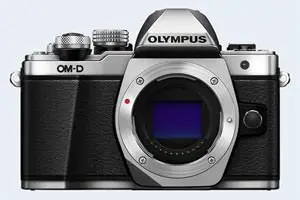Olympus E-M10 II vs Panasonic FZ1000
The Olympus OM-D E-M10 Mark II and the Panasonic Lumix DMC-FZ1000 are two digital cameras that were revealed to the public, respectively, in August 2015 and June 2014. The E-M10 II is a mirrorless interchangeable lens camera, while the FZ1000 is a fixed lens compact. The cameras are based on a Four Thirds (E-M10 II) and an one-inch (FZ1000) sensor. The Olympus has a resolution of 15.9 megapixels, whereas the Panasonic provides 20 MP.
Below is an overview of the main specs of the two cameras as a starting point for the comparison.

Check E-M10 II offers at
ebay.com

Check FZ1000 offers at
ebay.com
Going beyond this snapshot of core features and characteristics, what are the differences between the Olympus OM-D E-M10 Mark II and the Panasonic Lumix DMC-FZ1000? Which one should you buy? Read on to find out how these two cameras compare with respect to their body size, their imaging sensors, their shooting features, their input-output connections, and their reception by expert reviewers.
Body comparison
An illustration of the physical size and weight of the Olympus E-M10 II and the Panasonic FZ1000 is provided in the side-by-side display below. The two cameras are presented according to their relative size. Three consecutive perspectives from the front, the top, and the back are available. All size dimensions are rounded to the nearest millimeter.
The E-M10 II can be obtained in three different colors (black, silver, brown), while the FZ1000 is only available in black.
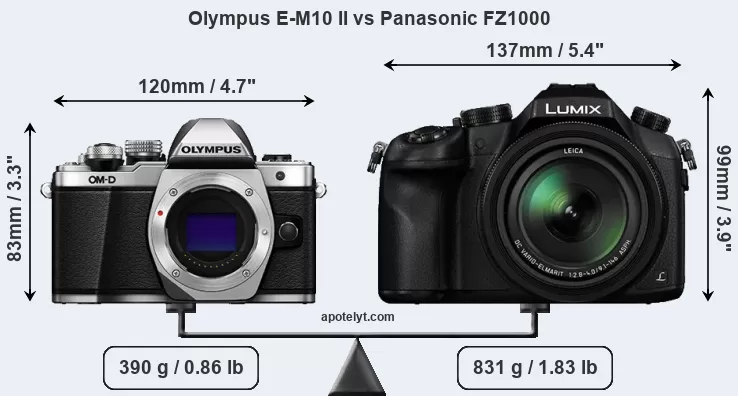
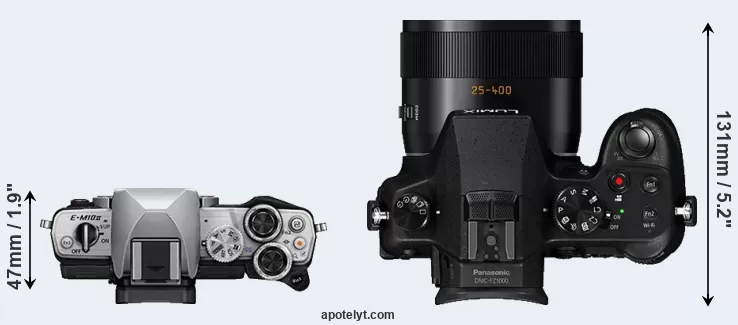
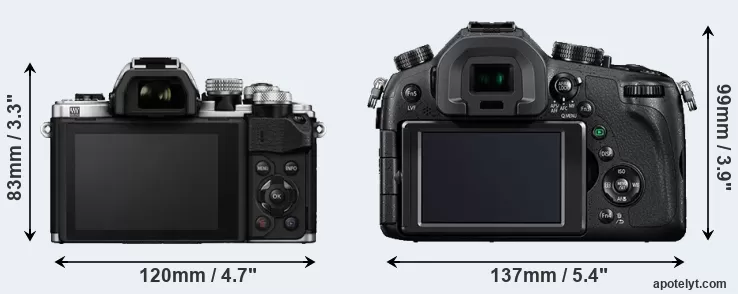
If the front view area (width x height) of the cameras is taken as an aggregate measure of their size, the Panasonic FZ1000 is notably larger (36 percent) than the Olympus E-M10 II. In this context, it is worth noting that neither the E-M10 II nor the FZ1000 are weather-sealed.
The above size and weight comparisons are to some extent incomplete and possibly misleading, as the FZ1000 has a lens built in, whereas the E-M10 II is an interchangeable lens camera that requires a separate lens. Attaching the latter will add extra weight and bulk to the setup. You can compare the optics available for the E-M10 II and their specifications in the Micro Four Thirds Lens Catalog.
Concerning battery life, the E-M10 II gets 320 shots out of its Olympus BLS-50 battery, while the FZ1000 can take 360 images on a single charge of its Panasonic DMW-BLC12 power pack.
The adjacent table lists the principal physical characteristics of the two cameras alongside a wider set of alternatives. If you would like to visualize and compare a different camera combination, you can navigate to the CAM-parator app and make your selection from a broad list of cameras there.

| Camera Model |
Camera Width |
Camera Height |
Camera Depth |
Camera Weight |
Battery Life |
Weather Sealing |
Camera Launch |
Launch Price (USD) |
Street Price |
||
|---|---|---|---|---|---|---|---|---|---|---|---|
| 1. | Olympus E-M10 II | 120 mm | 83 mm | 47 mm | 390 g | 320 | n | Aug 2015 | 649 | ebay.com | |
| 2. | Panasonic FZ1000 | 137 mm | 99 mm | 131 mm | 831 g | 360 | n | Jun 2014 | 899 | ebay.com | |
| 3. | Canon G3 X | 123 mm | 77 mm | 105 mm | 733 g | 300 | Y | Jun 2015 | 999 | ebay.com | |
| 4. | Canon G5 X | 112 mm | 76 mm | 44 mm | 353 g | 210 | n | Oct 2015 | 799 | ebay.com | |
| 5. | Olympus E-M10 | 119 mm | 82 mm | 46 mm | 396 g | 320 | n | Jan 2014 | 699 | ebay.com | |
| 6. | Olympus E-M10 III | 122 mm | 84 mm | 50 mm | 410 g | 330 | n | Aug 2017 | 649 | ebay.com | |
| 7. | Olympus E-P5 | 122 mm | 69 mm | 37 mm | 420 g | 330 | n | May 2013 | 999 | ebay.com | |
| 8. | Olympus E-PL5 | 111 mm | 64 mm | 38 mm | 325 g | 360 | n | Sep 2012 | 599 | ebay.com | |
| 9. | Olympus E-PL6 | 111 mm | 64 mm | 38 mm | 325 g | 360 | n | May 2013 | 599 | ebay.com | |
| 10. | Olympus E-PL7 | 115 mm | 67 mm | 38 mm | 357 g | 350 | n | Aug 2014 | 599 | ebay.com | |
| 11. | Olympus E-PL8 | 115 mm | 67 mm | 38 mm | 357 g | 350 | n | Sep 2016 | 549 | ebay.com | |
| 12. | Olympus E-PL9 | 117 mm | 68 mm | 39 mm | 380 g | 350 | n | Feb 2018 | 599 | ebay.com | |
| 13. | Olympus PEN-F | 125 mm | 72 mm | 37 mm | 427 g | 330 | n | Jan 2016 | 1,199 | ebay.com | |
| 14. | Panasonic GX85 | 122 mm | 71 mm | 44 mm | 426 g | 290 | n | Apr 2016 | 799 | amazon.com | |
| 15. | Sony RX100 II | 102 mm | 58 mm | 38 mm | 281 g | 350 | n | Jun 2013 | 749 | ebay.com | |
| 16. | Sony RX100 III | 102 mm | 58 mm | 41 mm | 290 g | 320 | n | May 2014 | 799 | ebay.com | |
| 17. | Sony RX100 IV | 102 mm | 58 mm | 41 mm | 298 g | 280 | n | Jun 2015 | 999 | ebay.com | |
| Note: Measurements and pricing do not include easily detachable parts, such as add-on or interchangeable lenses or optional viewfinders. | |||||||||||
Any camera decision will naturally be influenced heavily by the price. The manufacturer’s suggested retail prices give an idea on the placement of the camera in the maker’s lineup and the broader market. Usually, retail prices stay at first close to the launch price, but after several months, discounts become available. Later in the product cycle and, in particular, when the replacement model is about to appear, further discounting and stock clearance sales often push the camera price considerably down. Then, after the new model is out, very good deals can frequently be found on the pre-owned market.
Sensor comparison
The size of the sensor inside a digital camera is one of the key determinants of image quality. A large sensor will generally have larger individual pixels that offer better low-light sensitivity, provide wider dynamic range, and have richer color-depth than smaller pixels in a sensor of the same technological generation. Further, a large sensor camera will give the photographer additional creative options when using shallow depth-of-field to isolate a subject from its background. On the downside, larger sensors tend to be more expensive and lead to bigger and heavier cameras and lenses.
Of the two cameras under consideration, the Olympus E-M10 II features a Four Thirds sensor and the Panasonic FZ1000 an one-inch sensor. The sensor area in the FZ1000 is 48 percent smaller. As a result of these sensor size differences, the cameras have a format factor of, respectively, 2.0 and 2.7. The sensor in the E-M10 II has a native 4:3 aspect ratio, while the one in the FZ1000 offers a 3:2 aspect.
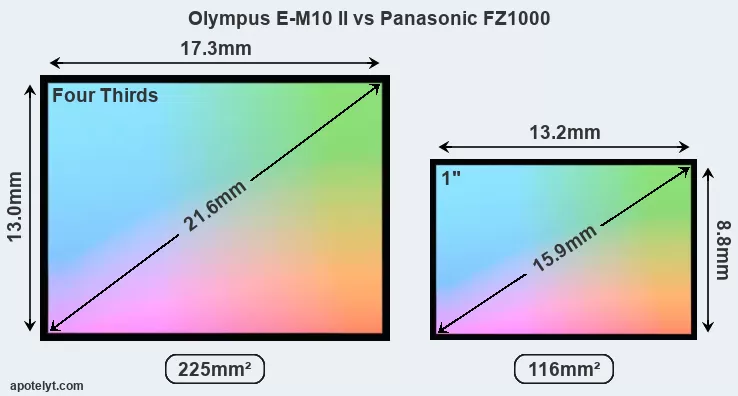
Despite having a smaller sensor, the FZ1000 offers a higher resolution of 20 megapixels, compared with 15.9 MP of the E-M10 II. This megapixels advantage comes at the cost of a higher pixel density and a smaller size of the individual pixel (with a pixel pitch of 2.41μm versus 3.76μm for the E-M10 II). Moreover, it should be noted that the E-M10 II is a somewhat more recent model (by 1 year and 2 months) than the FZ1000, and its sensor might have benefitted from technological advances during this time that further enhance the light gathering capacity of its pixels. Coming back to sensor resolution, it should be mentioned that the E-M10 II has no anti-alias filter installed, so that it can capture all the detail its sensor resolves.
The resolution advantage of the Panasonic FZ1000 implies greater flexibility for cropping images or the possibility to print larger pictures. The maximum print size of the FZ1000 for good quality output (200 dots per inch) amounts to 27.4 x 18.2 inches or 69.5 x 46.3 cm, for very good quality (250 dpi) 21.9 x 14.6 inches or 55.6 x 37.1 cm, and for excellent quality (300 dpi) 18.2 x 12.2 inches or 46.3 x 30.9 cm. The corresponding values for the Olympus E-M10 II are 23 x 17.3 inches or 58.5 x 43.9 cm for good quality, 18.4 x 13.8 inches or 46.8 x 35.1 cm for very good quality, and 15.4 x 11.5 inches or 39 x 29.3 cm for excellent quality prints.
The Olympus OM-D E-M10 Mark II has a native sensitivity range from ISO 200 to ISO 25600, which can be extended to ISO 100-25600. The corresponding ISO settings for the Panasonic Lumix DMC-FZ1000 are ISO 125 to ISO 12800, with the possibility to increase the ISO range to 80-25600.
Technology-wise, both cameras are equipped with CMOS (Complementary Metal–Oxide–Semiconductor) sensors. Both cameras use a Bayer filter for capturing RGB colors on a square grid of photosensors. This arrangement is found in most digital cameras.
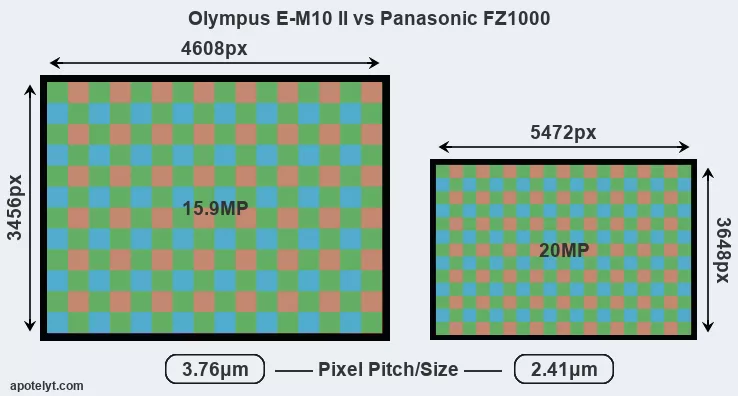
For many cameras, data on sensor performance has been reported by DXO Mark. This service assesses and scores the color depth ("DXO Portrait"), dynamic range ("DXO Landscape"), and low-light sensitivity ("DXO Sports") of camera sensors, and also publishes an overall camera score. Of the two cameras under review, the E-M10 II has a notably higher overall DXO score than the FZ1000 (overall score 9 points higher), which gives it an advantage in terms of imaging quality. This advantage is based on 1 bits higher color depth, 0.8 EV in additional dynamic range, and 0.7 stops in additional low light sensitivity. The adjacent table reports on the physical sensor characteristics and the outcomes of the DXO sensor quality tests for a sample of comparator-cameras.

| Camera Model |
Sensor Class |
Resolution (MP) |
Horiz. Pixels |
Vert. Pixels |
Video Format |
DXO Portrait |
DXO Landscape |
DXO Sports |
DXO Overall |
||
|---|---|---|---|---|---|---|---|---|---|---|---|
| 1. | Olympus E-M10 II | Four Thirds | 15.9 | 4608 | 3456 | 1080/60p | 23.1 | 12.5 | 842 | 73 | |
| 2. | Panasonic FZ1000 | 1-inch | 20.0 | 5472 | 3648 | 4K/30p | 22.1 | 11.7 | 517 | 64 | |
| 3. | Canon G3 X | 1-inch | 20.0 | 5472 | 3648 | 1080/60p | 21.4 | 12.3 | 521 | 63 | |
| 4. | Canon G5 X | 1-inch | 20.0 | 5472 | 3648 | 1080/60p | 21.4 | 12.3 | 471 | 62 | |
| 5. | Olympus E-M10 | Four Thirds | 15.9 | 4608 | 3456 | 1080/30p | 22.8 | 12.3 | 884 | 72 | |
| 6. | Olympus E-M10 III | Four Thirds | 15.9 | 4608 | 3456 | 4K/30p | 23.1 | 12.8 | 1120 | 74 | |
| 7. | Olympus E-P5 | Four Thirds | 15.9 | 4608 | 3456 | 1080/30p | 22.8 | 12.4 | 895 | 72 | |
| 8. | Olympus E-PL5 | Four Thirds | 15.9 | 4608 | 3456 | 1080/30p | 22.8 | 12.3 | 889 | 72 | |
| 9. | Olympus E-PL6 | Four Thirds | 15.9 | 4608 | 3456 | 1080/30p | 22.5 | 12.0 | 717 | 68 | |
| 10. | Olympus E-PL7 | Four Thirds | 15.9 | 4608 | 3456 | 1080/30p | 22.7 | 12.4 | 873 | 72 | |
| 11. | Olympus E-PL8 | Four Thirds | 15.9 | 4608 | 3456 | 1080/30p | 23.0 | 12.6 | 1030 | 73 | |
| 12. | Olympus E-PL9 | Four Thirds | 15.9 | 4608 | 3456 | 4K/30p | 23.1 | 12.8 | 1162 | 74 | |
| 13. | Olympus PEN-F | Four Thirds | 20.2 | 5184 | 3888 | 1080/60p | 23.1 | 12.4 | 894 | 74 | |
| 14. | Panasonic GX85 | Four Thirds | 15.8 | 4592 | 3448 | 4K/30p | 22.9 | 12.6 | 662 | 71 | |
| 15. | Sony RX100 II | 1-inch | 20.0 | 5472 | 3648 | 1080/60p | 22.5 | 12.4 | 483 | 67 | |
| 16. | Sony RX100 III | 1-inch | 20.0 | 5472 | 3648 | 1080/60p | 22.4 | 12.3 | 495 | 67 | |
| 17. | Sony RX100 IV | 1-inch | 20.0 | 5472 | 3648 | 4K/30p | 22.8 | 12.6 | 591 | 70 | |
| Note: DXO values in italics represent estimates based on sensor size and age. | |||||||||||
Many modern cameras are not only capable of taking still images, but also of capturing video footage. The two cameras under consideration both have sensors whose read-out speed is fast enough to capture moving pictures, but the FZ1000 provides a better video resolution than the E-M10 II. It can shoot movie footage at 4K/30p, while the Olympus is limited to 1080/60p.
Feature comparison
Apart from body and sensor, cameras can and do differ across a range of features. The two cameras under consideration are similar with respect to both having an electronic viewfinder. However, the one in the E-M10 II offers a slightly higher resolution than the one in the FZ1000 (2360k vs 2359k dots). The adjacent table lists some of the other core features of the Olympus E-M10 II and Panasonic FZ1000 along with similar information for a selection of comparators.

| Camera Model |
Viewfinder (Type or 000 dots) |
Control Panel (yes/no) |
LCD Specifications (inch/000 dots) |
LCD Attach- ment |
Touch Screen (yes/no) |
Max Shutter Speed * |
Max Shutter Flaps * |
Built-in Flash (yes/no) |
Built-in Image Stab |
||
|---|---|---|---|---|---|---|---|---|---|---|---|
| 1. | Olympus E-M10 II | 2360 | n | 3.0 / 1040 | tilting | Y | 1/4000s | 8.0/s | Y | Y | |
| 2. | Panasonic FZ1000 | 2359 | n | 3.0 / 921 | swivel | n | 1/4000s | 12.0/s | Y | Y | |
| 3. | Canon G3 X | optional | n | 3.2 / 1620 | tilting | Y | 1/2000s | 5.9/s | Y | Y | |
| 4. | Canon G5 X | 2360 | n | 3.0 / 1040 | swivel | Y | 1/2000s | 5.9/s | Y | Y | |
| 5. | Olympus E-M10 | 1440 | n | 3.0 / 1037 | tilting | Y | 1/4000s | 8.0/s | Y | Y | |
| 6. | Olympus E-M10 III | 2360 | n | 3.0 / 1040 | tilting | Y | 1/4000s | 8.6/s | Y | Y | |
| 7. | Olympus E-P5 | optional | n | 3.0 / 1037 | tilting | Y | 1/8000s | 9.0/s | Y | Y | |
| 8. | Olympus E-PL5 | optional | n | 3.0 / 460 | tilting | Y | 1/4000s | 8.0/s | n | Y | |
| 9. | Olympus E-PL6 | optional | n | 3.0 / 460 | tilting | Y | 1/4000s | 8.0/s | n | Y | |
| 10. | Olympus E-PL7 | optional | n | 3.0 / 1037 | tilting | Y | 1/4000s | 8.0/s | n | Y | |
| 11. | Olympus E-PL8 | optional | n | 3.0 / 1037 | tilting | Y | 1/4000s | 8.0/s | n | Y | |
| 12. | Olympus E-PL9 | none | n | 3.0 / 1040 | tilting | Y | 1/4000s | 8.6/s | Y | Y | |
| 13. | Olympus PEN-F | 2360 | n | 3.0 / 1037 | swivel | Y | 1/8000s | 10.0/s | n | Y | |
| 14. | Panasonic GX85 | 2765 | n | 3.0 / 1040 | tilting | Y | 1/4000s | 8.0/s | Y | Y | |
| 15. | Sony RX100 II | optional | n | 3.0 / 1229 | tilting | n | 1/2000s | 10.0/s | Y | Y | |
| 16. | Sony RX100 III | 1440 | n | 3.0 / 1229 | tilting | n | 1/2000s | 10.0/s | Y | Y | |
| 17. | Sony RX100 IV | 2359 | n | 3.0 / 1228 | tilting | n | 1/2000s | 16.0/s | Y | Y | |
| Note: *) Information refers to the mechanical shutter, unless the camera only has an electronic one. | |||||||||||
One differentiating feature between the two cameras concerns the touch sensitivity of the rear screen. The E-M10 II has a touchscreen, while the FZ1000 has a conventional panel. Touch control can be particularly helpful, for example, for setting the focus point.
The FZ1000 has an articulated screen that can be turned to be front-facing. This characteristic will be appreciated by vloggers and photographers who are interested in taking selfies. In contrast, the E-M10 II does not have a selfie-screen.The reported shutter speed information refers to the use of the mechanical shutter. Yet, some cameras only have an electronic shutter, while others have an electronic shutter in addition to a mechanical one. In fact, both cameras under consideration feature an electronic shutter, which makes completely silent shooting possible. However, this mode is less suitable for photographing moving objects (risk of rolling shutter) or shooting under artificial light sources (risk of flickering).
The Olympus E-M10 II and the Panasonic FZ1000 both have an intervalometer built-in. This enables the photographer to capture time lapse sequences, such as flower blooming, a sunset or moon rise, without purchasing an external camera trigger and related software.
Concerning the storage of imaging data, both the E-M10 II and the FZ1000 write their files to SDXC cards. Both cameras can use UHS-I cards, which provide for Ultra High Speed data transfer of up to 104 MB/s.
Connectivity comparison
For some imaging applications, the extent to which a camera can communicate with its environment can be an important aspect in the camera decision process. The table below provides an overview of the connectivity of the Olympus OM-D E-M10 Mark II and Panasonic Lumix DMC-FZ1000 and, in particular, the interfaces the cameras (and selected comparators) provide for accessory control and data transfer.

| Camera Model |
Hotshoe Port |
Internal Mic / Speaker |
Microphone Port |
Headphone Port |
HDMI Port |
USB Port |
WiFi Support |
NFC Support |
Bluetooth Support |
||
|---|---|---|---|---|---|---|---|---|---|---|---|
| 1. | Olympus E-M10 II | Y | stereo / mono | - | - | micro | 2.0 | Y | - | - | |
| 2. | Panasonic FZ1000 | Y | stereo / mono | Y | - | micro | 2.0 | Y | Y | - | |
| 3. | Canon G3 X | Y | stereo / mono | Y | Y | mini | 2.0 | Y | Y | - | |
| 4. | Canon G5 X | Y | stereo / mono | - | - | mini | 2.0 | Y | Y | - | |
| 5. | Olympus E-M10 | Y | stereo / mono | - | - | micro | 2.0 | Y | - | - | |
| 6. | Olympus E-M10 III | Y | stereo / mono | - | - | micro | 2.0 | Y | - | - | |
| 7. | Olympus E-P5 | Y | stereo / mono | - | - | micro | 2.0 | Y | - | - | |
| 8. | Olympus E-PL5 | Y | stereo / mono | - | - | mini | 2.0 | - | - | - | |
| 9. | Olympus E-PL6 | Y | stereo / mono | - | - | mini | 2.0 | - | - | - | |
| 10. | Olympus E-PL7 | Y | stereo / mono | - | - | micro | 2.0 | Y | - | - | |
| 11. | Olympus E-PL8 | Y | stereo / mono | - | - | micro | 2.0 | Y | - | - | |
| 12. | Olympus E-PL9 | Y | stereo / mono | - | - | micro | 2.0 | Y | - | Y | |
| 13. | Olympus PEN-F | Y | stereo / mono | - | - | micro | 2.0 | Y | - | - | |
| 14. | Panasonic GX85 | Y | stereo / mono | - | - | micro | 2.0 | Y | - | - | |
| 15. | Sony RX100 II | Y | stereo / mono | - | - | micro | 2.0 | Y | Y | - | |
| 16. | Sony RX100 III | - | stereo / mono | - | - | micro | 2.0 | Y | Y | - | |
| 17. | Sony RX100 IV | - | stereo / mono | - | - | micro | 2.0 | Y | Y | - |
It is notable that the FZ1000 has a microphone port, which can help to improve the quality of audio recordings by attaching an external microphone. The E-M10 II does not feature such a mic input.
Both the E-M10 II and the FZ1000 have been discontinued, but can regularly be found used on ebay. The FZ1000 was replaced by the Panasonic FZ2500, while the E-M10 II was followed by the Olympus E-M10 III. Further information on the features and operation of the E-M10 II and FZ1000 can be found, respectively, in the Olympus E-M10 II Manual (free pdf) or the online Panasonic FZ1000 Manual.
Review summary
So how do things add up? Which of the two cameras – the Olympus E-M10 II or the Panasonic FZ1000 – has the upper hand? Is one clearly better than the other? The listing below highlights the relative strengths of the two models.

Advantages of the Olympus OM-D E-M10 Mark II:
- Maximized detail: Lacks an anti-alias filter to exploit the sensor's full resolution potential.
- Better image quality: Scores markedly higher (9 points) in the DXO overall assessment.
- More dynamic range: Captures a larger spectrum of light and dark details (0.8 EV of extra DR).
- Better low-light sensitivity: Requires less light for good images (0.7 stops ISO advantage).
- More detailed LCD: Has a higher resolution rear screen (1040k vs 921k dots).
- Fewer buttons to press: Is equipped with a touch-sensitive rear screen to facilitate handling.
- More flexible: Accepts interchangeable lenses, so that lens characteristics can be altered.
- More compact: Is smaller (120x83mm vs 137x99mm) and thus needs less room in the bag.
- More modern: Is somewhat more recent (announced 1 year and 2 months after the FZ1000).

Arguments in favor of the Panasonic Lumix DMC-FZ1000:
- More detail: Has more megapixels (20 vs 15.9MP), which boosts linear resolution by 14%.
- Better moiré control: Has an anti-alias filter to avoid artificial patterns to appear in images.
- Better video: Provides higher definition movie capture (4K/30p vs 1080/60p).
- Better sound: Can connect to an external microphone for higher quality sound recording.
- Larger viewfinder image: Features a viewfinder with a higher magnification (0.70x vs 0.62x).
- More flexible LCD: Has a swivel screen for odd-angle shots in portrait or landscape orientation.
- More selfie-friendly: Has an articulated screen that can be turned to be front-facing.
- Faster burst: Shoots at higher frequency (12 vs 8 flaps/sec) to capture the decisive moment.
- Ready to shoot: Has an integrated lens, whereas the E-M10 II necessitates an extra lens.
- Longer lasting: Gets more shots (360 versus 320) out of a single battery charge.
- Easier device pairing: Supports NFC for fast wireless image transfer over short distances.
- More heavily discounted: Has been on the market for longer (launched in June 2014).
If the count of relative strengths (bullet points above) is taken as a measure, the FZ1000 emerges as the winner of the match-up (12 : 9 points). However, the relative importance of the various individual camera aspects will vary according to personal preferences and needs, so that you might like to apply corresponding weights to the particular features before making a decision on a new camera. A professional wildlife photographer will view the differences between cameras in a way that diverges from the perspective of a family photog, and a person interested in architecture has distinct needs from a sports shooter. Hence, the decision which camera is best and worth buying is often a very personal one.
How about other alternatives? Do the specifications of the Olympus E-M10 II and the Panasonic FZ1000 place the cameras among the top in their class? Find out in the latest Best Mirrorless Interchangeable Lens Camera and Best Superzoom Camera listings whether the two cameras rank among the cream of the crop.
In any case, while the comparison of technical specifications can provide a useful overview of the capabilities of different cameras, it remains incomplete and does no justice, for example, to the way the E-M10 II or the FZ1000 perform in practice. User reviews that are available, for instance, at amazon can sometimes shed light on these issues, but such feedback is all too often partial, inconsistent, and inaccurate.
Expert reviews
This is why expert reviews are important. The adjacent summary-table relays the overall verdicts of several of the most popular camera review sites (amateurphotographer [AP], cameralabs [CL], digitalcameraworld [DCW], dpreview [DPR], ephotozine [EPZ], photographyblog [PB]). As can be seen, the professional reviewers agree in many cases on the quality of different cameras, but sometimes their assessments diverge, reinforcing the earlier point that a camera decision is often a very personal choice.

| Camera Model |
AP score |
CL score |
DCW score |
DPR score |
EPZ score |
PB score |
Camera Launch |
Launch Price (USD) |
Street Price |
||
|---|---|---|---|---|---|---|---|---|---|---|---|
| 1. | Olympus E-M10 II | 4.5/5 | + + | .. | 80/100 | 5/5 | 5/5 | Aug 2015 | 649 | ebay.com | |
| 2. | Panasonic FZ1000 | 4/5 | + + | .. | 82/100 | 4.5/5 | 4.5/5 | Jun 2014 | 899 | ebay.com | |
| 3. | Canon G3 X | 3.5/5 | + | .. | .. | 4.5/5 | 4/5 | Jun 2015 | 999 | ebay.com | |
| 4. | Canon G5 X | 5/5 | + + | .. | 78/100 | 4.5/5 | 4.5/5 | Oct 2015 | 799 | ebay.com | |
| 5. | Olympus E-M10 | 4/5 | .. | .. | 80/100 | 5/5 | 5/5 | Jan 2014 | 699 | ebay.com | |
| 6. | Olympus E-M10 III | .. | + | 5/5 | 80/100 | 4.5/5 | 4.5/5 | Aug 2017 | 649 | ebay.com | |
| 7. | Olympus E-P5 | 5/5 | + + | .. | 78/100 | 4.5/5 | 5/5 | May 2013 | 999 | ebay.com | |
| 8. | Olympus E-PL5 | 3/5 | + + | .. | .. | 4.5/5 | 4.5/5 | Sep 2012 | 599 | ebay.com | |
| 9. | Olympus E-PL6 | .. | .. | .. | .. | .. | .. | May 2013 | 599 | ebay.com | |
| 10. | Olympus E-PL7 | 4/5 | + | .. | .. | 5/5 | 4/5 | Aug 2014 | 599 | ebay.com | |
| 11. | Olympus E-PL8 | .. | .. | .. | .. | 4.5/5 | 4/5 | Sep 2016 | 549 | ebay.com | |
| 12. | Olympus E-PL9 | .. | + | .. | .. | 4.5/5 | 4/5 | Feb 2018 | 599 | ebay.com | |
| 13. | Olympus PEN-F | .. | .. | 4/5 | 82/100 | 4.5/5 | 5/5 | Jan 2016 | 1,199 | ebay.com | |
| 14. | Panasonic GX85 | 4.5/5 | + + | .. | 82/100 | 5/5 | 5/5 | Apr 2016 | 799 | amazon.com | |
| 15. | Sony RX100 II | 5/5 | + + | .. | 79/100 | 4.5/5 | 4.5/5 | Jun 2013 | 749 | ebay.com | |
| 16. | Sony RX100 III | 5/5 | + + | .. | 82/100 | 4.5/5 | 5/5 | May 2014 | 799 | ebay.com | |
| 17. | Sony RX100 IV | 4.5/5 | + + | .. | 85/100 | 4/5 | 4.5/5 | Jun 2015 | 999 | ebay.com | |
| Note: (+ +) highly recommended; (+) recommended; (o) reviewed; (..) not available. | |||||||||||
The above review scores should be interpreted with care, though. The ratings are only valid when referring to cameras in the same category and of the same age. Hence, a score should always be seen in the context of the camera's market launch date and its price, and rating-comparisons among cameras that span long time periods or concern very differently equipped models make little sense. It should also be noted that some of the review sites have over time altered the way they render their verdicts.

Check E-M10 II offers at
ebay.com

Check FZ1000 offers at
ebay.com
Other camera comparisons
Did this review help to inform your camera decision process? If you would like to see a different side-by-side camera review, just make a corresponding selection in the search boxes below. As an alternative, you can also directly jump to any one of the listed comparisons that were previously generated by the CAM-parator tool.
- Canon M10 vs Olympus E-M10 II
- Canon M5 vs Olympus E-M10 II
- Canon R8 vs Olympus E-M10 II
- Canon SX60 vs Panasonic FZ1000
- Fujifilm X100F vs Panasonic FZ1000
- Leica S2 vs Panasonic FZ1000
- Nikon A1000 vs Panasonic FZ1000
- Nikon D2X vs Olympus E-M10 II
- Nikon D3X vs Panasonic FZ1000
- Olympus E-M10 II vs Olympus E-M5
- Olympus E-M10 II vs Sony NEX-5T
- Panasonic FZ1000 vs Sony A58
Specifications: Olympus E-M10 II vs Panasonic FZ1000
Below is a side-by-side comparison of the specs of the two cameras to facilitate a quick review of their differences and common features.
| Camera Model | Olympus E-M10 II | Panasonic FZ1000 |
|---|---|---|
| Camera Type | Mirrorless system camera | Fixed lens compact camera |
| Camera Lens | Micro Four Thirds lenses | 25-400mm f/2.8-4.0 |
| Launch Date | August 2015 | June 2014 |
| Launch Price | USD 649 | USD 899 |
| Sensor Specs | Olympus E-M10 II | Panasonic FZ1000 |
| Sensor Technology | CMOS | CMOS |
| Sensor Format | Four Thirds Sensor | 1" Sensor |
| Sensor Size | 17.3 x 13.0 mm | 13.2 x 8.8 mm |
| Sensor Area | 224.9 mm2 | 116.16 mm2 |
| Sensor Diagonal | 21.6 mm | 15.9 mm |
| Crop Factor | 2.0x | 2.7x |
| Sensor Resolution | 15.9 Megapixels | 20 Megapixels |
| Image Resolution | 4608 x 3456 pixels | 5472 x 3648 pixels |
| Pixel Pitch | 3.76 μm | 2.41 μm |
| Pixel Density | 7.08 MP/cm2 | 17.18 MP/cm2 |
| Moiré control | no AA filter | Anti-Alias filter |
| Movie Capability | 1080/60p Video | 4K/30p Video |
| ISO Setting | 200 - 25,600 ISO | 125 - 12,800 ISO |
| ISO Boost | 100 - 25,600 ISO | 80 - 25,600 ISO |
| Image Processor | TruePic VII | Venus |
| DXO Sensor Quality (score) | 73 | 64 |
| DXO Color Depth (bits) | 23.1 | 22.1 |
| DXO Dynamic Range (EV) | 12.5 | 11.7 |
| DXO Low Light (ISO) | 842 | 517 |
| Screen Specs | Olympus E-M10 II | Panasonic FZ1000 |
| Viewfinder Type | Electronic viewfinder | Electronic viewfinder |
| Viewfinder Field of View | 100% | 100% |
| Viewfinder Magnification | 0.62x | 0.70x |
| Viewfinder Resolution | 2360k dots | 2359k dots |
| LCD Framing | Live View | Live View |
| Rear LCD Size | 3.0inch | 3.0inch |
| LCD Resolution | 1040k dots | 921k dots |
| LCD Attachment | Tilting screen | Swivel screen |
| Touch Input | Touchscreen | no Touchscreen |
| Shooting Specs | Olympus E-M10 II | Panasonic FZ1000 |
| Focus System | Contrast-detect AF | Contrast-detect AF |
| Manual Focusing Aid | Focus Peaking | Focus Peaking |
| Max Shutter Speed (mechanical) | 1/4000s | 1/4000s |
| Continuous Shooting | 8 shutter flaps/s | 12 shutter flaps/s |
| Electronic Shutter | up to 1/16000s | up to 1/16000s |
| Time-Lapse Photography | Intervalometer built-in | Intervalometer built-in |
| Image Stabilization | In-body stabilization | Lens-based stabilization |
| Fill Flash | Built-in Flash | Built-in Flash |
| Storage Medium | SDXC cards | SDXC cards |
| Single or Dual Card Slots | Single card slot | Single card slot |
| UHS card support | UHS-I | UHS-I |
| Connectivity Specs | Olympus E-M10 II | Panasonic FZ1000 |
| External Flash | Hotshoe | Hotshoe |
| USB Connector | USB 2.0 | USB 2.0 |
| HDMI Port | micro HDMI | micro HDMI |
| Microphone Port | no MIC socket | External MIC port |
| Wifi Support | Wifi built-in | Wifi built-in |
| Near-Field Communication | no NFC | NFC built-in |
| Body Specs | Olympus E-M10 II | Panasonic FZ1000 |
| Battery Type | Olympus BLS-50 | Panasonic DMW-BLC12 |
| Battery Life (CIPA) | 320 shots per charge | 360 shots per charge |
| Body Dimensions |
120 x 83 x 47 mm (4.7 x 3.3 x 1.9 in) |
137 x 99 x 131 mm (5.4 x 3.9 x 5.2 in) |
| Camera Weight | 390 g (13.8 oz) | 831 g (29.3 oz) |

Check E-M10 II offers at
ebay.com

Check FZ1000 offers at
ebay.com
Did you notice an error on this page? If so, please get in touch, so that we can correct the information.
